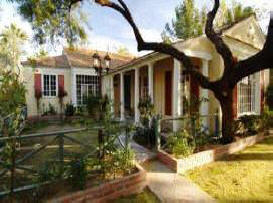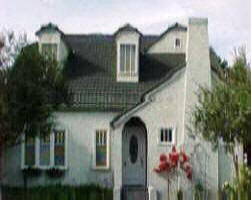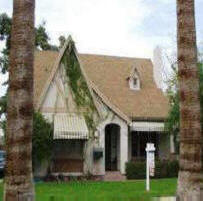Earll Place
Historical District Maps, Information & Homes Search
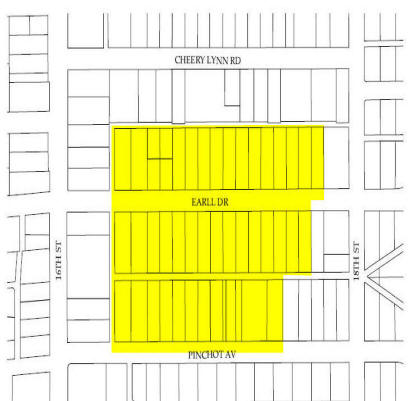
1620-1722 East Pinchot
Avenue, 1617-1731 and 1736 East Earll Drive, Phoenix,
Arizona (110 acres, 39 buildings)
Earll Place Historic District
History
Until the 1920's, the area that would become
Earll Place remained cultivated for agriculture.
This area was situated between the Creighton District
and the Osborn District, two mini farm districts that
utilized water coming from the nearby Grand Canal.
Roosevelt Damn’s completion in 1911 brought a dependable
source of water to Phoenix, and instigated a population
boom. This in turn prompted some small owners to
subdivide their holdings into smaller residential lots.
Phoenix’s population growth slowed substantially in 1914
at the onset of World War I, but increased sharply after
the war.
In the 1920's,
Phoenix saw unprecedented agricultural and
commercial production, promoting another population
boom. The spiraling population increase also affected
the physical dimensions of the city, as residential
development rapidly extended the rural-urban interface
in all directions from the city center. Meeting the
demand for suburban residential land outside the city,
landowners platted 36 new subdivisions in the six months
leading up to March 1927. This expansion included farm
lands to the north and east of the city. E. A. Earll
subdivided his land north of Thomas Road and east of
16th Street in February of 1927.
E. A. Earll offered bare lots for sale and also built
several houses on speculation. The first house offered
for sale was an English Tudor-style residence Earll
built at 1626 E. Pinchot. By early March 1927,
Earll’s builder, George McGinnis, started construction
on three more Tudor Revival and Bungalow brick homes.
The large lots, all measuring a quarter or third of an
acre had soft water pumped to the site. Earll invested
in several improvements, including graded gravel roads,
service alleys, and electricity available at the “low
suburban rate.” Children in the district could use the
Creighton school district bus.
In February, Earll offered the quarter-acre tracts
for $350 and the third-acre lots for $385. The homes had
many modern conveniences: “wonderful kitchen, containing
Lasto sink, Hotpoint automatic range, electric water
heater, breakfast nook, etc. Just the place for the
discriminating housewife.” A buyer could have this home
for $4,750, or a smaller but similar one at 1681 E.
Earll Drive for just $3,900. Homeowners could enjoy
“city conveniences and no city taxes.” By February 1928,
Earll had invested $75,000 worth of improvements in the
subdivision, and had sold two homes that he had built on
speculation.
Property values in the suburbs northeast of town had
risen significantly after the
Biltmore interests announced their plans to build
the new two million dollar Biltmore Hotel near Squaw
Peak. By March 25, 1928, Earll had increased lot prices
to $395 and up for 50 x 175 lots and $500 for 65 x 175
lots, but he did offer 5% off for cash payment. Builder
C. W. Harvey bought a few Earll Place lots as
investments and built the Spanish Stucco
Bungalow on the double lot at 1642 E.
Pinchot on speculation, after moving into his own home
at 1636 E. Pinchot. By 1930, Earll had sold all of the
lots in Earll Place, although four homes built on
speculation remained vacant until 1931.
Earll capitalized on the growing popularity of the
automobile as a lifestyle necessity of the new
suburbanite. Earll assumed his customers would be
driving to see Earll Place and would need garage space
when they moved there. Most of his homes included
detached one- or two-car garages. As the Phoenix
streetcar system ultimately failed, it is just as well
that Earll Place residents had so enthusiastically
embraced automobile culture.
The stock market crash in 1929 slowed, but did not
halt, Phoenix’s growth. Unlike cities in the industrial
north and east, Phoenix’s strong agricultural economy,
increasingly diversified business community, and status
as the state government center kept the city alive, but
still financially shaken. New Deal programs instituted
in the 1930s helped many people in need, and established
government guidelines and procedures that endured
through the twentieth century. However, most of the
homes built in Earll Place reflect the style and unique
characteristics of the Period Revival and Bungalow
styles of the pre-FHA era of building.
Architecture
Earll Place contains mostly English Tudor, Bungalow and
Spanish Colonial Revival homes built by E. A. Earll’s builders.
George McGinnis built most of the English Tudor and Bungalow
homes in the neighborhood, and contractor C. W. Harvey built
Spanish revival homes on speculation. Earll’s speculative
efforts were very successful, as all of his homes sold within
four years, even during the early years of the Great Depression.
Earll’s advertising strategy included the appeal of the suburban
“country estate,” exemplified by the charming cottage exterior
and custom wood interior details, while also promoting modern
conveniences such as electric light switches and modern kitchen
appliances.
Typical features of the Bungalow Style include single-story
massing with large, covered front porches; multiple gabled roofs
of medium to low pitch with broad eaves and exposed, sometimes
decoratively cut rafter tails; the use of massive piers, often
tapered, to support porch roofs; and often the use of rustic
materials for wall sheathing such as wood shingles,
cobblestones, clinker brick, and pebble-dashed stucco.
Development of the Earll Place Historic District began at the
end of the bungalow’s popularity, and only 13 of the
district’s 42 homes were bungalows.
The English Tudor Revival Style is marked by high pitched
gables, usually front-facing, and stylistic details such as
half-timbering in the gables, arched entryways, arcaded wing
walls, and sweeping eaves. Twelve of the homes in Earll Place
employed the English Tudor Revival style.
Spanish Colonial Revival homes employ forms and details to
evoke early Spanish architecture in the new world. Roofs are
usually gabled, with tile roofs, and walls are stuccoed. Other
details may include round arched openings, arcaded wing walls,
and a combination of flat roofs and pitched roofs. There are two
Spanish Colonial Revival homes in Earll Place.
The Southwest Style is a blend of Spanish Colonial and Pueblo
elements. Wall surfaces are stuccoed, and the roof has
predominantly flat roofed forms with occasional tile accents as
awnings, porch roofs, or parapet caps. Porch and door openings
have arched details. Six homes in Earll Place are categorized as
Southwest Style.
Information, maps and photographs
provided courtesy: Historic Preservation Office of the City of
Phoenix Neighborhood Services Department
200 West Washington Street
Phoenix, Arizona 85003
(602) 261-8699
|
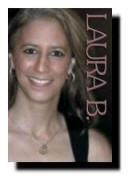
Laura Boyajian
Mobile: 602.400.0008
HistoricCentralPhoenix@cox.net
HomeSmart, LLC
5225 N. Central Ave. #104
Phoenix, AZ 85012
(602)
400.0008

|
